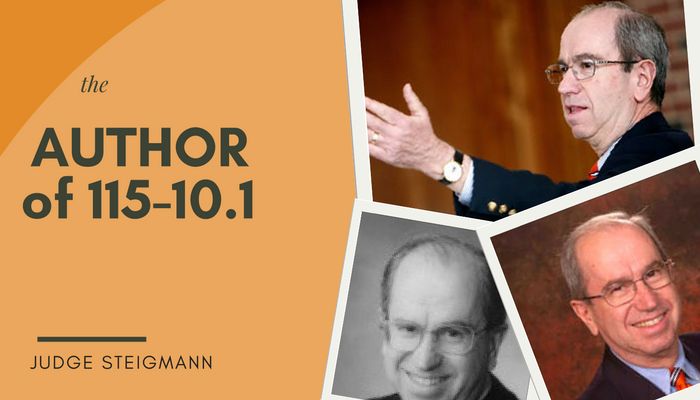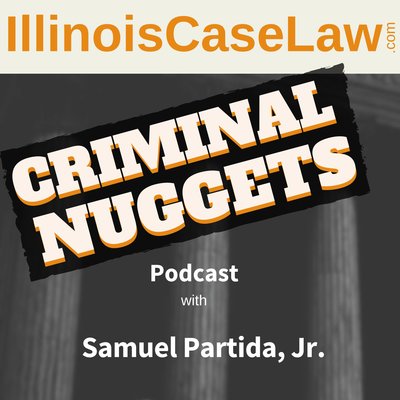Nov 10, 2016
The most Honorable Judge Robert Steigmann of the Fourth Appellate District provides valuable insight and lessons on proper impeachment, prior inconsistent statements, and 725 ILCS 5/115-10.1.
Episode 256 (Duration 47:16). Prepare for valuable insight, trial lessons, and behind the scenes action from one of Illinois's most respected judges.

Subscribe: iTunes | Google Play | Android | RSS | Direct Download
iTunes Google Play Android RSS
Download
If you don’t do anything else, at least download the cheat-sheet and other impeachment/prior inconsistent statement resources I put together to ensure you don’t ever make another error on this topic.
Download This Impeachment & Prior Inconsistent Statement Checklist

Download now.
Add To My Library Now
Is Judge Steigmann The Longest Serving Illinois Judge?
I actually don't know the answer to this question.
But check out these numbers:
In 1977 Robert Steigmann ran for judge and won at the age of 31. Before that he was a prosecutor at the Champaign County State's Attorney's Office. He was there 5 years. He also served 2 years at the Sangamon County State's Attorney's Office, and worked for one year at the legislative reference bureau right out of law school.
Judge Stegmann was a 6th Judicial Circuit (Champaign) trial judge for 12 years.
Since 1989 he has been on the Fourth Appellate District. That's 28 years. In total he's been on the bench for 40 years!
I asked him directly if retirement was right around the corner.
He's reply was that it's time to retire when the EMT says, "We can't revive him."
Topics Covered
In this discussion Judge Steigman revealed the following information.
- Difference Between Impeachment & 725 ILCS 5/115-10.1
- Origins Story For 725 ILCS 5/115-10.1
- Biggest Mistakes Attorneys Are Making
- Glaring Benefits of The Statute That Go Unused
- Great Examples Of How To Do It Right
- Encouraging Reminder That Trials Are Truth Seeking Endeavours
Law School Examples
Making sense of the topics discussed will be a little easier if you know these "law school" type scenarios used by the judge through the discussion.
The Traffic Scenario
In this scenario, the judge reverts to an old civil law problem.
A traffic accident is being litigated and the central issues revolves around who had the green light.
The witness testifies in court that the green car had the green light. However, right after the accident the witness tells the police that he wasn't sure who had the green light, but thought it might have been the white car.
Obviously, the lawyer for the white car driver is going to want to impeach this witness.
Rape Case He Tried
The judge remembered an old rape case that he prosecuted.
This was before prior inconsistent statements could be argued substantively. Here's what happened:
Defendant was charged with rape. The victim had blood and mud on her body. Defendant's grandmother (Grandma) remembered that the defendant came home late that day.
He had blood and mud on his clothes.
Interestingly, for the first time in his entire life, that night he did the laundry. He washed the very clothes he came home in. At the trial, Grandma didn't remember anymore.
The judge would have liked the jury to have known what she told the cops.
Important Links & Resources
- 725 ILCS 5/115-10.1
- Illinois Rule of Evidence 613(b)
- Illinois Rule of Evidence 801(d)(1)(A)
- Illinois Rule of Evidence 607
- Illinois Evidence Manual, 4th
- Graham's Handbook of Illinois Evidence
- People v. Brothers, 2015 IL App (4th) 130644 (September 2015) (acknowledge hearing explained)
- The Affirmative Damage Rule
- See Also Paul Meyers On Why Experienced Attorneys Still Confuse Impeachment, Substantive Evidence, and Prior Inconsistent Statements
- See Also Prior Inconsistent Statement Impeachment Is Not Necessarily a Thing
- See Also Two Step Formula To Avoid Prior Inconsistent Statement Error
- See Also Better Read This If You Are An Illinois Trial Attorney
- See Also Illinois Criminal Pattern Jury Instruction 3.11 (pay attention to the committee notes)
More Highlights From The Podcast
✓ How lawyers are not keeping up with the bare bone fundamentals of impeaching a witness. Even trial judges have been known to stop a lawyer who's doing it right because the trial judge is confused about how it should be done. Steigmann walks us through doing it right. (Go to 3:15)
✓ Time, place, location, and as specific as you can be - all day baby - It's that easy! And basic impeachment requires presenting extrinsic evidence if you get the "no" or any "hemming and hawing". (Go to 4:44)
✓ The Judge begins with Rule 613(b). Know it, and everything else falls right into place.
✓ The absolutely WRONG QUESTION to ask when you're perfecting impeachment. The right way is super simple, yet this improper question is asked as frequently as you catch the bailiff snoring. (Go to 6:19)
✓ This one-two combo of ineptness drives The Judge crazy. Especially, when it's written down right there in black and white for all to read, process, understand and execute correctly. (Go to 7:05)
✓ There are all kinds of witnesses in a trial. An impeachment witness has one simple task and role to play. Know this role and you'll never make a mistake. (Go to 7:20)
✓ Here is some interesting information I bet you've never heard on how and why Judge Steigmann decided to write the legislation for 725 ILCS 5/115-10.1. He wrote this law 33 years ago and argued for it's passage when he was still a prosecutor. His own problems with witnesses and fundamental roadblocks to truth seeking played big a big part. (Go to 7:36)
✓ Know this and things will fit better in your head: prior inconsistent statements under 725 ILCS 5/115-10.1 were built right on top of the existing rules and procedures for impeachment.
✓ Listen to The Judge describe a case where a defendant was acquitted of a shooting on a directed finding because a prosecutor did not properly impeach the civilian witnesses. This happened in his home county in downtown Champaign. The police played it by the book and recorded the statements, but the jury never heard them! (Go to 8:35)
✓ Here is the easiest way to define impeachment. (Go to 9:59)
✓ Foundation, Foundation, Foundation. (Go to 11:24) & (27:45)
✓ Some prosecutors complain about how technical the rules can get. This is how The Judge responds to these complaints. (Go to 11:50) Also, at 18:12 The Judge explains that this stuff sounds technical, but it's actually quite easy.
✓ Before Judge Steigman drafted 725 ILCS 5/115-10.1 he took a case to the Illinois Supreme Court inviting the high court to allow impeachment to be used as substantive evidence. The Supreme Court of the United States had just allowed California to do it so he felt good about his chances. He lost. 7 - 0. No hard feelings. (Go to 13:04)
✓ Here is the easiest way to explain the difference between impeachment under rule 613(b) and prior inconsistent statements under 725 ILCS 5/115-10.1 (Go to 15:42)
✓ What's up with Illinois Supreme Court Rule 801(d)? Were they just trying to validate Judge Steigmann's work? (Go to 17:31)
✓ Here is the easiest way to define substantive evidence. Hint: Everything is substantive unless it isn't. (Go to 18:12)
✓ Originally, The Judge's first draft of 725 ILCS 5/115-10.1 had no extrinsic evidence requirement (no requirement that the statement be written, recorded or acknowledged). Can you guess why Chicago legislatures said this was a "no-go"? (Go to 19:22)
✓ In it's 33 years of existence, prosecutors still don't have a clue about the "acknowledgment hearing" or how to use it. Trial life could get so easy for them if they just bothered to look this up. If they're serious about this they'll start with People v. Brothers, 2015 IL App (4th) 130644 (September 2015). (Go to 20:42- 24:55)
✓ The ordinary rules of impeachment say when your witness claims to "not remember anything" or insists he "never said that" you absolutely CANNOT IMPEACH him. See the affirmative damage rule...but this is precisely where the statute comes to the rescue. (Go to 21:09)
✓ Listen carefully, this is how to and when to conduct an acknowledgment hearing under (c)(2)(B). Defense attorneys, I'm talking to you too. After the acknowledgement, you can tune out, it doesn't matter one bit what gibberish dribbles from the witness. (Go to 22:12)
✓ WARNING: 725 ILCS 5/115-10.1 contains no language limiting the use of this rule to prosecutors only. Defense attorneys can use it as well. Pay attention here to see how. (Go to 25:02) Also jump to 38:39 to see how the defense can "lock-in" an alibi witness.
✓ Not doing this, actually, merely being unprepared to do this may constitute plain error. Definitely add this to your list of things "not to do". (Go to 28:04)
✓ The judge gives some Straightforward trial advice used by clever litigators. Get your pens out and write down these short tips. Once you write it down then internalize it. Then, look out. (Go to 32:04)
✓ Know this: There is a clear difference between merely having a "good faith basis" and having "extrinsic evidence" lined up waiting in the hallway ready to perfect your impeachment. The Judge reveals one of his law school final exam questions here. (Go to 33:56)
✓ What's the jury trial equivalent of a free shot or a football's "Hail Mary"? (Go to 34:14)
✓ Difference between merely being disappointed by your witness and being affirmatively damaged by that person's testimony. Why does it matter? (Go to 36:09)
✓ TO DEFENSE LAWYERS: Judge Steigman presents the most important takeaway nugget of information you should know about this issue. (Go to 40:25)
Download This Impeachment & Prior Inconsistent Statement Checklist

Download now.
Add To My Library Now



